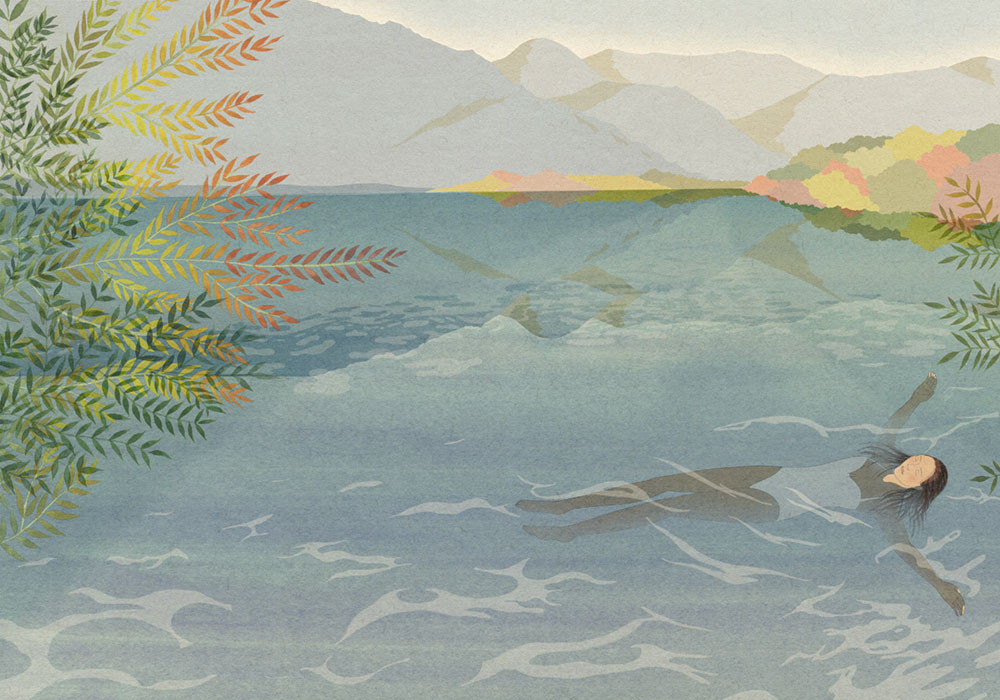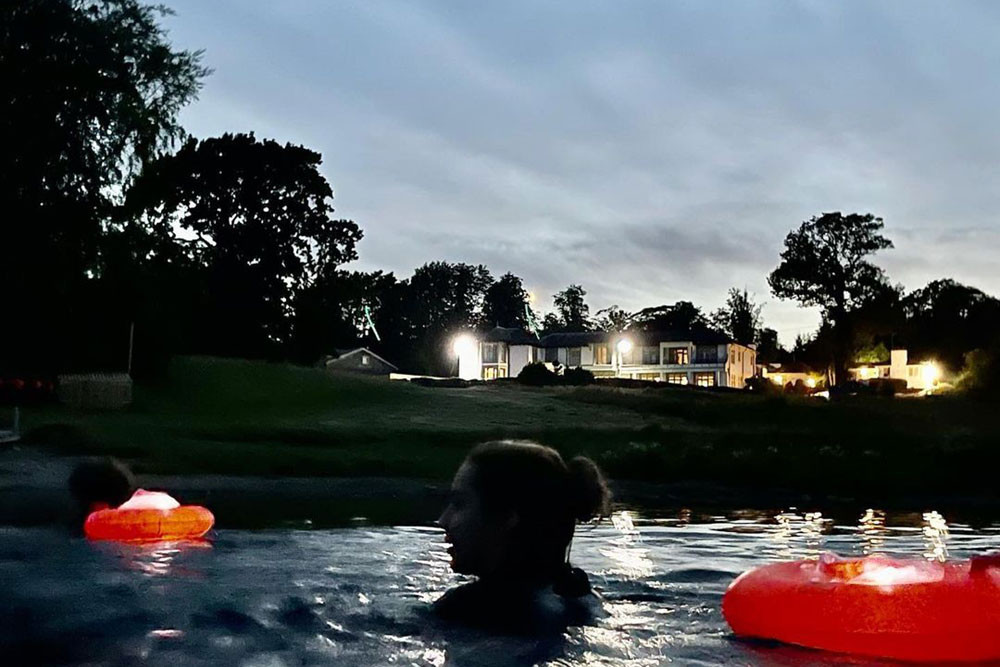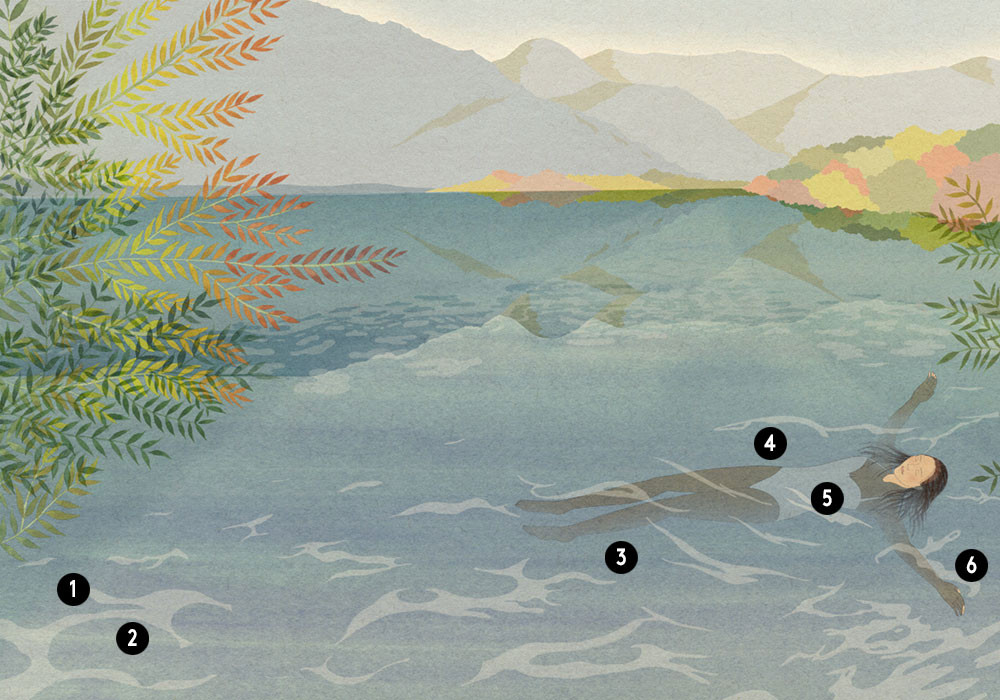Strokes and floats
(4 minute read)
From still lakes to waterfall plunge pools, swimming beneath the open sky is infamously addictive. But there’s more to it than simply mastering your stroke: sometimes it’s just as important to lie back and soak up your surroundings. Another Place’s open water swimming expert, Colin Hill, shares his tips on getting the most from your float…

Illustration by Harriet Lee-Merrion
Anyone who’s ever plunged themselves into wild water will know the sensations. The tingle of anticipation as you shed your clothes. The nervous chatter as you gather courage and walk down to the shore. The shock of cold as your foot touches the water, and the electric rush of adrenaline as you immerse your body. And then, of course, the serenity that descends as your body adjusts and you settle into your stroke: the calm, the stillness, the peace.
Colin Hill leads guided swims in Ullswater nearly every day of the year, and he knows better than anyone how to help people get the most out of their time in the water. He’s helped hundreds of swimmers perfect their strokes, learn to regulate their breathing and become more confident in the water. But there’s one thing many swimmers (even experienced ones) overlook, he thinks – and that’s the simple joy of floating.
“I know how exciting swimming in cold water is, regardless of whether it’s your first time or you do it several times a week,” he says. “But my time on Ullswater has taught me another lesson: the importance of stillness. I’ve learned the importance of just being in the water – appreciating the sensations, and taking in your surroundings. I’ve seen triathletes who treat it like just another training session – straight in, straight out, check your time on Strava – but it shouldn’t be like that. Wild swimming is a different experience, and for me, floating is an important part of that.”
My time on Ullswater has taught me a lesson: the importance of stillness. I’ve learned the importance of just being in he water – appreciating the sensations, and taking in your surroundings.

Time to float
Colin now incorporates floating time into all his guided swims on the lake. Usually, he allows a few minutes for his students to breast-stroke and get acclimatised to the water temperature. Then, after a while, he asks them to stop, lie on their backs and place their tow float behind their heads, focusing on the silence, the sky overhead, the sounds and sensations of nature. It can be a transformative experience.
“When you’re swimming, you’re thinking about all these different things – your stroke, your breathing, your body posture,” he says. “But when you’re floating, there’s nothing to think about except what it feels like. You start to notice things: the patterns of the clouds, the sound of the water, the colours of the fells. It’s amazing how this simple act changes the experience. Suddenly you’re not just in nature, you’re part of it. That’s what open water swimming is all about.’
You start to notice things: the patterns of the clouds, the sound of the water, the colours of the fells. It’s amazing how this simple act changes the experience. Suddenly you’re not just in nature, you’re part of it.

Float beneath the stars
Colin is particularly fond of floating on a night swim. “It’s such an incredible feeling,” he says. “To be out on the dark, silent lake, with nothing but the full moon overhead, or a sky full of stars. If you’ve never done it before, I promise you – you’ll never forget your first night float. Magical is the only word for it. But even if it’s a cloudy night, it’s still amazing to be floating on the water in the dark.”

Colin’s top floating tips
1.Time your floating sessions for the quietest times of day – early morning or evening are best.
2.Give yourself time in the water to allow your body temperature to regulate. A few minutes of head-up breast stroke are an ideal warm-up.
3.When you’re ready to stop and float, roll onto your back, spread your arms and legs slightly, then try to completely relax – especially your head and neck.
4.Push your hips up and forward; the hips need to be an extension of your back.
5.Your lungs also need to be flat – this helps you float – so your back has to be flat too. Visualising it can really help.
6.Don’t float for too long, as you will get cold more quickly than when swimming. Be alert for warning signs, like slurred speech, shivering or coldness in your extremities.
7.Be aware that you will be hard to see when on your back floating – a brightly coloured tow float or swim hat aids visibility. There are over 200 lakes and tarns in the Lake District, so you can also choose a body of water with no boats on if you prefer.
8.If you’re not an experienced swimmer, it’s best to swim in groups – and perhaps do your floating one or two at a time, rather than all together.
9.Having a tow float is really helpful: you can use it as a buoyancy aid or a pillow to rest your head on when you’re floating (which can really help, as your head is the heaviest part of your body).
Discover the whole range of guided and open water swimming experiences at Another Place, The Lake